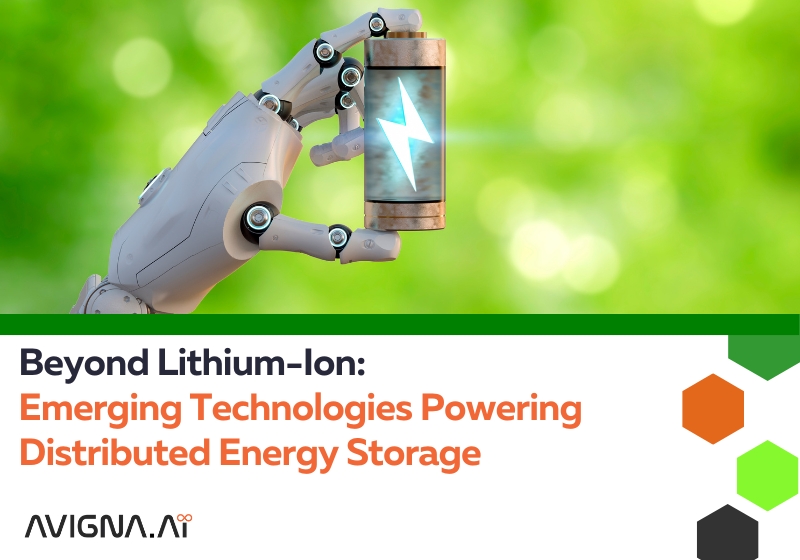Beyond Lithium-Ion: Emerging Technologies Powering Distributed Energy Storage
Lithium-ion batteries have been among the most popular energy storage devices. However, they have some limitations. With technological advancements, there is a need for alternatives. Scientists have now developed next-generation energy storage technologies. These include solid-state batteries, flow batteries and many more. In this article, I will talk about these new technologies and the related distributed energy storage innovations, how they tackled the challenges at hand, and also assess the impact at large.
Trends in Energy Storage Landscape
Before discussing different forms of energy storage systems, here are some trends depicting the growth of such systems.
- Battery prices have seen an 85%-drop, from $1,100/kWh in 2010 to $137/kWh in 2020. Another 55% drop is expected by 2030.
- India generated 175 GW of renewable energy by 2022, which is expected to hit 450 GW by 2030.
- Investments in energy storage worldwide shall touch the $620 billion mark by 2040.
Solid-State Batteries
One of the promising solutions for the classic lithium-ion batteries is the solid-state battery. These energy storage devices replace the liquid electrolyte commonly present in conventional batteries for a solid, non-flammable medium. Thus, it eliminates any thermal runaways and other safety concerns.
Their inherent safety features provided by the solid electrolyte are a game-changer, especially when safety is of concern. They are extremely helpful in electric vehicles and grid-scale energy storage. They give tremendous confidence and reliability by inhibiting any possibilities of fire and explosions.
Besides, solid-state batteries have a much higher energy density in comparison with liquid-based batteries. This is a vital factor in applications where weight and volume matter a lot, for example, portable electronics and electric aviation.
High energy density in lighter storage systems is opening up new avenues for transportation electrification and further development of electronic gadgets.
 ROI Calculator for Distributed Energy Storage Systems
ROI Calculator for Distributed Energy Storage Systems
Lithium-Sulfur Batteries
Traditional lithium-ion batteries rely on intercalation chemistry. Li-S batteries work on nature of using sulfur which is abundant and has high energy density. Conventional lithium-ion batteries generally have energy densities of 150-250 Wh/kg, while the Li-S batteries could very well be around 500 Wh/kg. It has the possibility of reaching 1,000 Wh/kg in theory. These levels of mass and volume specific energy density never witnessed before. Therefore, Li-S batteries have caught much attention for ultra-lightweight applications, including electric aviation, long-range electric vehicles, and portable electronics.
However, the commercialization of lithium-sulfur batteries comes with many technical difficulties. One of the primary obstacles is polysulfide dissolution, which results in the “shuttle effect”. It is the loss of active material and shortened life cycles. This challenge has been under active research, with the focus on solving it through innovative methods like nanoengineering of sulfur cathodes, new electrolyte chemistries, and coatings.
Innovations in lithium-sulfur batteries have recently demonstrated some breakthroughs in stabilizing the sulfur cathode and counteracting the dissolution of polysulfides. Hence, improvements have been made, promoting the immediate prospects of Li-S batteries for large-scale applications. Especially manufacturers of electric vehicles have seen that Li-S technology greatly extends vehicle range, one of the biggest weaknesses of present-day lithium-ion solutions.
Flow Batteries
In flow batteries energy storage works differently, as it separates the power-generation systems from the energy-capacity systems. In conventional batteries energy and power are mutually locked in one cell. Whereas, the energy in flow batteries is stored by liquid electrolytes contained within external tanks. Owing to its architecture, power and energy can be scaled independently. Thus, flow batteries become the best candidates for long-duration storage. Having the modularity of the flow battery system means unprecedented flexibility in the distributed energy storage environment. The energy capacity scales with the volume of the electrolyte tanks. This means the storage systems can be custom-fitted to any application needs, from short-term grid stabilization to multi-day renewable-energy storage.
Vanadium redox flow batteries (VRFBs) currently represent the best flow battery offerings due to their chemical stability and long cycle life. Through the use of vanadium ions in different oxidation states, VRFBs avoid the cross-contamination problems faced by other flow battery chemistries. VRFBs have been demonstrated by commercial installations to undergo over 10,000 cycles with degradation being almost negligible, making them quite attractive for long-term energy storage applications.
Other chemistries for flow batteries are emerging to solve the cost and availability issues of vanadium. Iron-chromium flow batteries harbor abundant, cheap materials while affording long cycle life. Organic flow batteries based on quinone chemistry offer an alternative that might be cheaper and hence environmentally conscientious in profile. This would greatly extend the applications for flow batteries when their costs come down and their performance goes up.
Gravity-Based Energy Storage
Energy can be stored and discharged by gravity-based energy storage systems using potential energy stored in increased masses. Generally, the system would lift the weights, comprising concrete blocks or water, to a certain height, and would discharge electric power by running a generator down via the energy of gravity at a time when energy needs to be dispatched into the grid.
One key advantage of gravity-based energy storage is its sheer simplicity and robustness. Gravity-based storage relies on elementary mechanical principles and hence is relatively simple and easy to implement. This simplicity, in turn, ensures that storage systems are more reliable and last longer as they have fewer moving parts and suffer less degradation.
In addition, gravity-based energy storage systems can easily be scaled to meet grid-scale applications. Energy can be stored in high amount by designing the elevated masses to be much heavier, or having more storage sites, , thereby satisfying the energy requirements of local power grids and renewable energy generation facilities.
The other advantage is the potential interface of this type of energy storage with renewable energy sources, such as wind and solar energy. The energy from the wind and solar power are used to raise heavy masses. The energy gets stored in these masses and released when required.
Gravity-based storage may not satisfy the same energy density requirements provided by advanced batteries. However, it still offers an enticing solution for grid-level energy storage. The one thing that keep it going is that it is simple and scalable. Thus, it integrates perfectly with renewable energy systems that form a nice complement to further distributed energy technologies.
Thermal Energy Storage
Thermal energy storage using carbon blocks represents an innovative approach to long-duration energy storage. In this, excess electricity is used, for heating a thermal medium such as molten salts, concrete, or phase-change materials at 2000 degree Celsius. This stored thermal energy can be converted again into electricity at a time of need through TPV cells or heat engines.
Storage of thermal energy brings in a long-duration storage advantage. In contrast, battery energy storage charging and discharging cycles may limit storing energy for a long. Thermal energy storage can remain in stored energy form for many days or months. This makes it suitable for grid-scale long-term energy storage.
Another feature is that these thermal energy storage systems can be made very scalable. Storage capacity only depends on how much thermal storage space is provided. This opens opportunities to implement large utility-grade thermal energy storage plants. They can appreciably contribute to the overall energy storage capacity of a distributed grid.
There is another intriguing possibility in terms of coordination with renewable energy sources.
When excess renewable energy is generated, the surplus electricity can be diverted to charging the thermal storage system to store energy in the form of heat. The thermal energy stored can be reconverted to electricity as a fairly reliable and sustainable power source anytime when needed.
Thermal energy storage may not provide as much energy density as advanced battery technologies. But it nevertheless provides a unique, complementary solution for grid-scale energy storage applications. It is able to store energy long-term, is scalable, and has synergy with renewable energy systems. These make it worthy of consideration in the stand-alone energy storage landscape.
Hydrogen-Based Energy Storage
The main principle behind hydrogen energy storage is the splitting of water molecules into oxygen and hydrogen through the action of electricity. The electricity used for water splitting is generated by renewable sources. Hydrogen can be stored as a compressed gas or in compounds rich in hydrogen, and can later be used to produce electricity via fuel cells or other conversion methods.
Hydrogen can be used to power fuel cell vehicles or provide storage at the grid scale. This high level of flexibility enables the integration of hydrogen-based systems into various chunks of the energy ecosystem that could fit perfectly with a more energy management-oriented holistic and decentralized agenda.
Another worthy highlight is that hydrogen-based energy storage has the potential for long-duration storage. Battery systems are limited in the duration of their charge-discharge cycles. Hydrogen-based storage can preserve its stored energy indefinitely, thus making it a feasible alternative for grid-level applications. This makes hydrogen a profound choice when it comes to long-term energy storage.
There have been some hurdles in the development of hydrogen-based storage technologies. For example, enhancing water electrolysis efficiency and fuel cell technologies, the other areas have witnessed considerable acceleration. Governments and industries across the globe have been appreciating the huge potential of hydrogen-based systems to heavily invest in the drive to solve these problems.
Integrating Renewable Energy
Distributed energy storage is one of the few systems that ensure the integration of renewable energy sources into the grid. These systems allow energy to be stored when there is a high output of renewable generation. Then released into the grid at times of high demand or low renewable generation, smoothing out fluctuations in the power supply.
The important point that it achieves is improving the stability and resilience of the grid. Hence, any system providing localized energy storage can offer distributed storage. It can help with grid outages and support the integration of renewable energy sources, paramount to an almost reliable and efficient power supply.
Furthermore, distributed energy storage creates an environment for microgrids to exist.
Microgrids are localized, self-sufficient power grids capable of operating independently in conjunction with the main grid. The existence of microgrids, by virtue of integrating distributed energy storage, increases the levels of energy security and resilience, especially for remote or off-grid areas.
The importance of distributed energy storage goes further than grid stability and renewable energy integration. Also, nowadays these systems are moving with AI and machine learning algorithms. These algorithms can predict energy demand patterns and optimize storage system operation to maximize economic returns while maintaining grid stability.
A Portfolio Approach to Energy Storage
The path to an energy empowered future is not an easy one. Therefore, it is not possible to just go on with one technology. What people need is the integration of different technologies so that they can benefit each section of society. With collective groups of researchers, industry leaders, and policymakers, progress is being made every day.
Faster realization of transformative energy storage will only take place through addressing the technical, economic, and regulatory obstacles on the way. Finally, it will create a more sustainable, resilient, and equitable distributed energy ecosystem.
Join Our Mission
Join our mission in building a connected world. At AvignaAI, we are passionate about harnessing IoT, advanced storage technologies, and renewable energies to drive smarter, sustainable operations. Let’s explore how these technologies can transform your business. Contact us or send us an email to queries@avigna.ai. Connect with us on LinkedIn to receive our latest updates.






